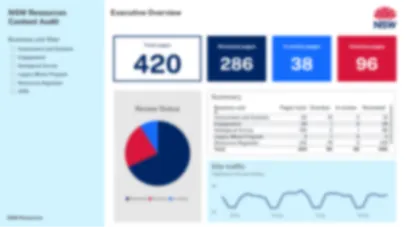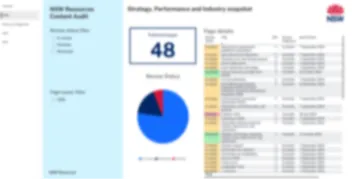
Luhur Abdi RizalDeveloper
Post co-authored with NSW Resources. A critical issue with the management of content currency on our Drupal website, nsw.gov.au/nswresources required an innovative solution to provide us with an automated content audit process.
Due to the complexity and size of our Drupal web presence, ensuring each page was up-to-date and reviewed by the appropriate business unit became increasingly challenging. We needed a tool to track how long it had been since a page was reviewed, set specific periods for future reviews and easily identify the page owners for each section of the website. Furthermore, with the required frequency of daily updates to the site, the solution had to be ‘live’ to accurately reflect these changes.
To tackle these challenges, we collaborated with our Drupal web development partner, PreviousNext, to create a live .csv file of all relevant web pages. This file included custom metadata detailing each page’s review frequency, page owner, date of last page update, date of last content review, publishing status and the next scheduled review date. By using this .csv file as a data source, we built a user-friendly content audit report dashboard in Microsoft Power BI.
The PowerBI dashboard provides executives with a high-level overview of which sections of the website are most in need of review. A complementary dashboard for ‘content champions’ offers a more granular view of the status of each individual page, enabling targeted content management.
Implementing this solution involved several steps:
We engaged with the various business units in NSW Resources division to identify page owners and establish appropriate review periods for each section of the website.
Metadata bulk-uploaded to the pages included the custom metadata fields created for the project, such as review periods and page owners.
Data from the .csv file was manipulated within PowerBI to ensure that columns were in the correct format. We created a 'Review status' column based on the next date of review to provide clear visibility. We also filtered out any unpublished or archived content to make it more streamlined.
Using the dataset from the website's metadata and Google Analytics, we built a comprehensive dashboard in PowerBI Desktop and then uploaded it to PowerBI Service for broader access. Live links to the web pages were integrated into the dashboards for easy navigation.
We developed a high-level summary report that shows how many pages each business unit is responsible for and includes Google Analytics page views from the past 30 days.

This report provides filtering by review status and sub-areas within each business unit, offering direct links to the listed web pages and conditional formatting utilising a traffic light system for review status indicators.


Designed to be used exclusively by the NSW Resources website team, this site-wide and document overview provides an overall tracker, including documents, events, and articles that are not part of other reports.

PowerBI reports were integrated into Microsoft Teams and the SharePoint intranet, facilitating use across the business.
The form was updated to distinguish whether a web update is part of a comprehensive content audit review, therefore requiring a review period reset, or just a minor adjustment that means the review status remains unchanged.
The project required extensive consultation to define the scope and needs of each business unit. Following this, identifying the correct page owners, along with setting appropriate review periods, posed significant challenges.
As business units sometimes want entire website sections to be marked as reviewed with a change in the review period, the Drupal-side dashboard allowed for bulk changes to both owners and review periods by uploading a revised version of the .csv file, saving substantial time.
Understanding the correct licensing requirements for PowerBI was another challenge. After consulting with our internal IT team, a group workspace was set up under an enterprise agreement, and an individual licence was obtained for the team member managing the dashboards.
To ensure effectiveness, the solution was initially tested in a development environment that mirrored the production site. This approach allowed us to test the limitations and user experience prior to going live. During this phase, we tested the bulk upload of the .csv file to update page metadata.
A soft launch of the content audit dashboard provided valuable insights, such as the realisation that a three-month review period was too short, given the number of pages each business unit manages.
As a result of this testing period, we made minor adjustments, such as requiring a defined review period for each page and allowing users to opt-out of updates considered a ‘review’ for reporting purposes. This might include, for example, correcting a typo, which doesn’t constitute a page review in the context of the content audit dashboard.
This solution significantly enhanced reporting capabilities across NSW Resources, reducing the need for manual intervention. Now, page updates are easily reflected in the report dashboard automatically.
The PowerBI dashboards offer real-time updates and clear visibility of page ownership and review status, making it easier for business units to manage their content.
Business units can independently track the currency of their pages without needing data from the digital team, streamlining the process and increasing efficiency.
The solution will continue to evolve. We plan to use the work done on the PowerBI integration to inform future website improvements with the potential for further Google Analytics data integration.
A document audit is currently a separate and opt-in process for business units, but future plans may involve greater integration.
Overall, this innovative solution addresses a critical need for NSW Resources by providing a robust, automated and user-friendly content audit process that adapts to the dynamic nature of our Drupal website.